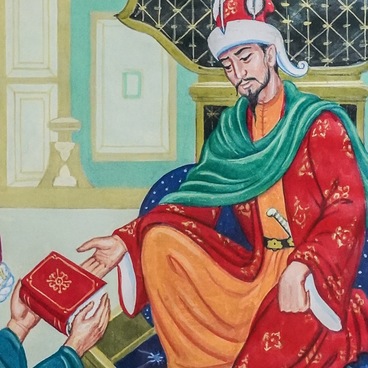This dish was created in the 19th century, no later than in 1883, at Kuznetsov Porcelain Factory famous for its high-quality products. The artist having painted this big faience dish remained unknown. The underglaze painting and gilding – the two very popular techniques at that time – were used for decorating the dish. The author combined geometric and floral ornaments with calligraphy.
At that time, dishes citing the Koran verses were of high demand with the Islam followers. This resulted in the decision by the management of the most famous porcelain factory in Russia to start making such dishes.
Terentiy Yakovlevich Kuznetsov of the Old-Believers launched the porcelain factory in Dulyovo village of Vladimir Province in 1832. Now this village belongs to Moscow Region. After the dissent of Russian Orthodox Church, the Old-Believers occupied this village, saving themselves from the prosecution by tsar Alexey Romanov and his son Peter I.
The Old-Believers called Peter the Great the Antichrist and refused to go to the military service and from any other homage in favour of the state. However, there were many active and talented people among them, and the spheres where they could utilise their talent were trade and industry. Terentiy Kuznetsov, the founder of the factory, came from those circles. Later, his descendants continued to develop the enterprise successfully.
In 1846, his grandson Mikhail established Kuznetsov Partnership for manufacturing porcelain and faience ware. Mikhail was the one to become the ‘lord of porcelain and faience’, and his enterprise acquired popularity all over the world. The partnership participated in international exhibitions in different countries on a regular basis, and inalterably received high awards. In 1913, the enterprise reached its zenith.
Soviet government nationalized all the factories of Kuznetsov Partnership and refocused them on manufacturing mass products of low quality. Being in the hands of the government, the enterprises saw both highs and lows, but were never able to achieve the same level of success.
The cause of Terentiy Kuznetsov and his descendants received new life in 1990, when a creative team of artists and enthusiasts decided to renew the famous factory. Starting from 1997, the factory manufactures national artisanal items by private orders and by commission of Moscow Mayor’s Office, the Administration of the RF President and other organisations.
At that time, dishes citing the Koran verses were of high demand with the Islam followers. This resulted in the decision by the management of the most famous porcelain factory in Russia to start making such dishes.
Terentiy Yakovlevich Kuznetsov of the Old-Believers launched the porcelain factory in Dulyovo village of Vladimir Province in 1832. Now this village belongs to Moscow Region. After the dissent of Russian Orthodox Church, the Old-Believers occupied this village, saving themselves from the prosecution by tsar Alexey Romanov and his son Peter I.
The Old-Believers called Peter the Great the Antichrist and refused to go to the military service and from any other homage in favour of the state. However, there were many active and talented people among them, and the spheres where they could utilise their talent were trade and industry. Terentiy Kuznetsov, the founder of the factory, came from those circles. Later, his descendants continued to develop the enterprise successfully.
In 1846, his grandson Mikhail established Kuznetsov Partnership for manufacturing porcelain and faience ware. Mikhail was the one to become the ‘lord of porcelain and faience’, and his enterprise acquired popularity all over the world. The partnership participated in international exhibitions in different countries on a regular basis, and inalterably received high awards. In 1913, the enterprise reached its zenith.
Soviet government nationalized all the factories of Kuznetsov Partnership and refocused them on manufacturing mass products of low quality. Being in the hands of the government, the enterprises saw both highs and lows, but were never able to achieve the same level of success.
The cause of Terentiy Kuznetsov and his descendants received new life in 1990, when a creative team of artists and enthusiasts decided to renew the famous factory. Starting from 1997, the factory manufactures national artisanal items by private orders and by commission of Moscow Mayor’s Office, the Administration of the RF President and other organisations.

